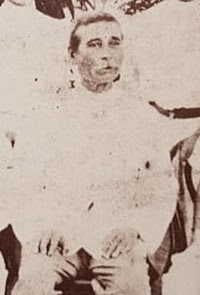The 1918 Spanish Influenza pandemic hit Guam like a ton of bricks.
It began in November and, by the end of that month, more people had died in one month than in entire years prior to the pandemic. Some 673 Guam residents died that month alone, and in the entire year prior to this, in 1917, only 243 Guam had died. So many people were dying daily that carts were brought up and down Hagåtña's street picking up bodies to be buried quickly at Pigo cemetery.
The flu was very bad on the elderly. Some of the island's oldest people died in November 1918. Every human life is precious, but some stand out because they were patriarchs or matriarchs of large clans, or were notable people in the community or lived to a very long age. Here are some of them who died in November 1918 during the pandemic.
GREGORIO CRUZ PÉREZ
Goyo
HUSBAND AND WIFE DIE DAYS APART
Gregorio Cruz Pérez and Rosa Aguon Flores
GREGORIO CRUZ PÉREZ was the founder of the Goyo clan of Perezes, which has played an important part in Guam's recent history. Gregorio himself was a big landowner and held some civic posts, including Associate Judge. Some of his descendants include Guam politicians (including a Governor, Felix Camacho) and businessmen. He died at age 71.
Just two days later, in the same pandemic, his wife ROSA AGUON FLORES, of the Kabesa clan, passed away at age 75. They are buried in the family cemetery in Yigo.
NICOLÁS AND AGUSTÍN EVARISTO DUEÑAS
Brothers
Two brothers, from a respectable family who themselves are the patriarchs of many descendants, died days apart because of the pandemic.
NICOLÁS EVARISTO DUEÑAS was the grandfather of Father Jesús Baza Dueñas, only the 2nd Chamorro priest ordained in history and who was executed by the Japanese in 1944. He is also the great grandfather of Judge Cristóbal Camacho Dueñas. He was 87 when he died.
His younger brother AGUSTÍN died not long after. Agustín is the founder of Oting clan, and another branch coming from the Oting clan is the Kaila family. He died at age 74.
KATSON
One branch of Aflagues are known as the Katson family. VICENTE FLORES AFLAGUE was one of them, the son of Manuel Camacho Aflague who served as a judge during Spanish times. Vicente's mother was Saturnina Manalisay Flores.
Just 54 years old, Vicente died from the Spanish influenza.
He was the great grandfather of Governor Lourdes Aflague León Guerrero.
ANTONIO PANGELINAN MARTÍNEZ
Although he did not leave many male descendants, ANTONIO PANGELINAN MARTÍNEZ, while he lived, was one of Guam's highest level elites. He had tremendous land holdings, including a cattle ranch in Dandan. His several daughters married prominent men, including foreigners. He died from influenza at the age of 81.
KUETO
JUANA PÉREZ SAN NICOLÁS was the matriarch of the large Kueto clan. Her husband, who did not die from influenza and who lived many more years after the pandemic, was José Mendiola Taitano, a former whaler. When a Protestant mission was opened on Guam as soon as the Americans took over Guam, José'n Kueto joined them. Juana was 68 when she died, leaving behind many children whose descendants include many politicians, including a Governor (Carl Gutiérrez). She is buried in the Custino (General Baptist) Cemetery in what is now called East Agaña.
HUSBAND AND WIFE DIE SAME DAY
Down in Sumay, a husband and wife died from influenza on the same day. They were FRANCISCO GUZMÁN SABLAN, aged 80, and his wife ANDREA DÍAZ PÉREZ, aged 73. What a sad day for that family to have to bury both spouses on the same day. They left many descendants.
OTHERS
Others who perished in the pandemic were PEDRO GUZMÁN SABLAN, the grandfather of Baptist minister Reverend Joaquín Flores Sablan. He was 76.
FÉLIX BORJA PANGELINAN, of the numerous Kotla clan, died at age 45. Still being relatively young, his widow remarried.
TITO QUICHOCHO BAZA, patriarch of many Bazas in Yoña and a large landowner, died of influenza at age 59.
MARÍA LUJÁN IGLESIAS was 54 when she died of influenza. She was the grandmother of Agueda Iglesias Johnston.
OLDEST
The oldest victim of the Spanish Influenza of 1918 we have on record was JOSEFA DEMAPAN TANOÑA. She was 99 years old, and possibly older, since ages were notoriously inaccurate in those days, as many people could neither read nor write and documentation was not only unnecessary but also useless to many people in those days.
Josefa was married to a Borja and they had land in Cañada, Barrigada.
And so, these members of Guam's past and present history pictured above, a Protestant minister, a Catholic priest, a leading island educator and a Governor of Guam all lost a grandparent or great grandparent in the Spanish Influenza pandemic in 1918 that took the lives of over 600 people on Guam in pretty much a month's time.




























.jpg)










.jpg)
